<Back to Index>
- Physicist Murray Gell-Mann, 1929
- Physicist Yuval Ne'eman, 1925
PAGE SPONSOR
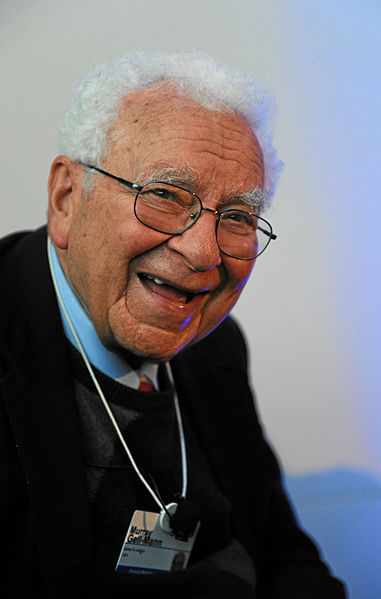
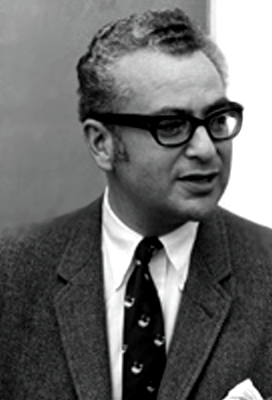
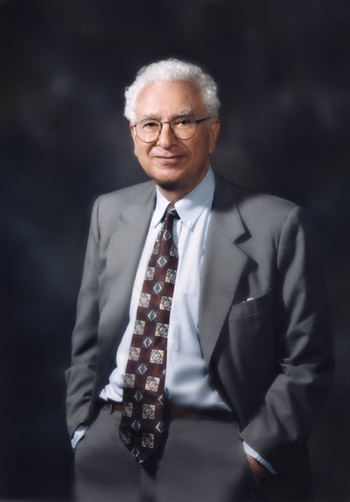
Murray Gell-Mann (September 15, 1929 - May 24, 2019) was an American physicist who received the 1969 Nobel Prize in physics for his work on the theory of elementary particles. He was the Robert Andrews Millikan Professor of Theoretical Physics Emeritus at Caltech, a Distinguished Fellow and co-founder of the Santa Fe Institute, Professor in the Physics and Astronomy Department of the University of New Mexico, and the Presidential Professor of Physics and Medicine at the University of Southern California.
He formulated the quark model of hadronic resonances, and identified the SU(3) flavor symmetry of the light quarks, extending isospin to include strangeness, which he also discovered. He developed the V-A theory of the weak interaction in collaboration with Richard Feynman. He created current algebra in the 1960s as a way of extracting predictions from quark models when the fundamental theory was still murky, which led to model - independent sum rules confirmed by experiment.
Gell-Mann, along with Maurice Lévy, developed the sigma model of pions, which describes low energy pion interactions. Modifying the integer - charged quark model of Han and Nambu, Fritzsch and Gell-Mann were the first to write down the modern accepted theory of quantum chromodynamics, although they did not anticipate asymptotic freedom. In 1969 he received the Nobel Prize in physics for his contributions and discoveries concerning the classification of elementary particles and their interactions.
Gell-Mann was responsible for the see-saw theory of neutrino masses, that produces masses at the inverse - GUT scale in any theory with a right - handed neutrino, like the SO(10) model. He is also known to have played a large role in keeping string theory alive through the 1970s and early 1980s, supporting that line of research at a time when it was unpopular.
Gell-Mann was born in lower Manhattan into a family of Jewish immigrants from the Austro - Hungarian Empire, Gell-Mann quickly revealed himself as a child prodigy. Propelled by an intense boyhood curiosity and love for nature and mathematics, he graduated valedictorian from the Columbia Grammar & Preparatory School and subsequently entered Yale at the age of 15 as a member of Jonathan Edwards College. At Yale, he participated in the William Lowell Putnam Mathematical Competition and was on the team representing Yale University (along with Murray Gerstenhaber and Henry O. Pollak) that won the second prize in 1947. In 1948, Gell-Mann earned a bachelor's degree in Physics and went on to attend graduate school at MIT where he received his PhD in physics in 1951.
Gell-Mann's work in the 1950s involved recently discovered cosmic ray particles that came to be called kaons and hyperons. Classifying these particles led him to propose that a quantum number called strangeness would be conserved by the strong and the electromagnetic interactions, but not by the weak interactions. Another of Gell-Mann's ideas is the Gell-Mann-Okubo formula, which was, initially, a formula based on empirical results, but was later explained by the quark model. Gell-Mann and Abraham Pais were involved in explaining many puzzling aspects of the physics of these particles.
In 1961, this led him (and Kazuhiko Nishijima) to introduce a classification scheme for hadrons, elementary particles that participate in the strong interaction. (This scheme was independently proposed by Yuval Ne'eman.) This scheme is now explained by the quark model. Gell-Mann referred to the scheme as the Eightfold Way, because of the octets of particles in the classification. The term is a reference to the eightfold way of Buddhism.
In 1964, Gell-Mann and George Zweig, independently, went on to postulate the existence of quarks, particles of which hadrons are composed. The name was coined by Gell-Mann and is a reference to the novel Finnegans Wake, by James Joyce ("Three quarks for Muster Mark!" book 2, episode 4). Zweig had referred to the particles as "aces", but Gell-Mann's name caught on. Quarks, antiquarks, and gluons were soon accepted as the underlying elementary objects in the study of the structure of hadrons. In 1972 he and Harald Fritzsch introduced the conserved quantum number "color charge", and later along with Heinrich Leutwyler, they introduced quantum chromodynamics (QCD) as the gauge theory of the strong interaction. The quark model is a part of QCD, and it has been robust enough to survive the discovery of new "flavors" of quarks.
Gell-Mann and Richard Feynman, working together, along with the independent duo of George Sudarshan and Robert Marshak, were the first to discover the vector and axial vector structures of the weak interaction in physics. This work followed the experimental discovery of the violation of parity by Chien - Shiung Wu, as suggested by Chen Ning Yang and Tsung-Dao Lee, theoretically.
During the 1990s, Gell-Mann's interest turned to the emerging study of complexity. He played a central role in the founding of the Santa Fe Institute. He wrote a popular science book about these matters, The Quark and the Jaguar: Adventures in the Simple and the Complex. The title of the book is taken from a line of a poem by Arthur Sze: "The world of the quark has everything to do with a jaguar circling in the night."
Gell-Mann was an avid birdwatcher, a collector of antiquities, rancher, and a keen linguist. Along with S.A. Starostin, he established the Evolution of Human Languages project at the Santa Fe Institute.
The author George Johnson has written a biography of Gell-Mann, which is titled Strange Beauty: Murray Gell-Mann, and the Revolution in 20th-Century Physics, which Gell-Mann criticized as inaccurate. The Nobel prize winning physicist Philip Anderson, in his chapter on Gell-Mann, says that Johnson's biography is excellent. Both Anderson and Johnson say that Gell-Mann is a perfectionist and that his semibiographical, The Quark and the Jaguar is consequently incomplete.
Gell-Mann earned a bachelor's degree in physics from Yale University in 1948, and a PhD in physics from MIT in 1951. He was a postdoctoral fellow at the Institute for Advanced Study in 1951, and a visiting research professor at the University of Illinois at Urbana – Champaign from 1952 to 1953. He was a visiting associate professor at Columbia University and an associate professor at the University of Chicago in 1954 - 55 before moving to the California Institute of Technology, where he taught from 1955 until he retired in 1993. He was awarded a Nobel Prize in physics in 1969 for his contributions and discoveries concerning the classification of elementary particles and their interactions.
He was later the Robert Andrews Millikan Professor of Theoretical Physics Emeritus at Caltech as well as a University Professor in the Physics and Astronomy Department of the University of New Mexico in Albuquerque, New Mexico and the Presidential Professor of Physics and Medicine at the University of Southern California. He was a member of the editorial board of the Encyclopædia Britannica. In 1984 Gell-Mann co-founded the Santa Fe Institute — a non-profit theoretical research institute in Santa Fe, New Mexico — to study complex systems and disseminate the notion of a separate interdisciplinary study of complexity theory.
Gell-Mann married Marcia Southwick in 1992, after the death of his first wife, J. Margaret Dow (d. 1981), whom he married in 1955. His children are Elizabeth Sarah Gell-Mann (b. 1956) and Nicholas Webster Gell-Mann (b. 1963); and he had a stepson, Nicholas Southwick Levis (b. 1978). Gell-Mann’s partner since 2007 was the international art dealer and non-fiction writer Michelle Gaugy.
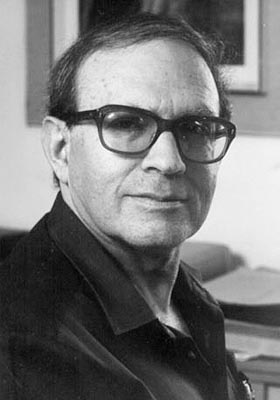
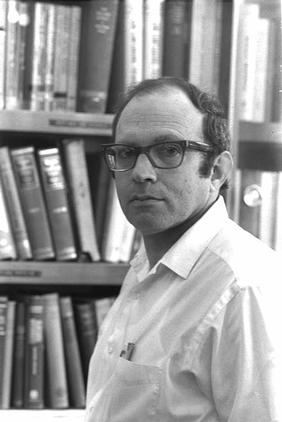
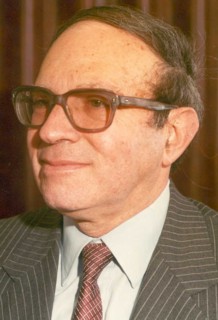
Yuval Ne'eman (Hebrew: יובל נאמן, 14 May 1925 – 26 April 2006), was a renowned Israeli theoretical physicist, military scientist, and politician. He was a minister in the Israeli government in the 1980s and early 1990s.
Yuval Ne'eman was born in Tel Aviv during the Mandate era, graduated from high school at the age of 15, and studied mechanical engineering at the Technion.
At the age of 15, Ne'eman also joined the Haganah. During the 1948 Arab - Israeli War Ne'eman served in the Israeli Defense Forces (IDF) as battalion deputy commander, then as Operations Officer of Tel Aviv, and commander of Givati Brigade.
Later (1952 – 54) he served as Deputy Commander of Operations Department of General Staff, Commander of Planning Department of IDF. In this role, he helped organize the IDF into a reservist - based army, developed the mobilization system, and wrote the first draft of the Israel defense doctrine.
Between 1958 and 1960 Ne'eman was IDF Attaché in Great Britain, where he also studied for a PhD in physics under the supervision of 1979 Nobel Prize in Physics winner Abdus Salam at Imperial College London. In 1961, he was demobilized from the IDF with a rank of Colonel.
One of his greatest achievements in physics was his 1961 discovery of the classification of hadrons through the SU(3) flavor symmetry, now named the Eightfold Way, which was also proposed independently by Murray Gell-Mann. This SU(3) symmetry laid the foundation of the quark model, proposed by Gell-Mann and George Zweig in 1964 (independently of each other).
Ne'eman was founder and director of the School of Physics and Astronomy at Tel Aviv University from 1965 to 1972, president of Tel Aviv University from 1971 to 1975, and director of its Sackler Institute of Advanced Studies from 1979 to 1997. He was also the co-director (along with Sudarshan) of the Center for Particle Theory at the University of Texas, Austin from 1968 to 1990. He was a strong believer in the importance of space research and satellites to Israel's economic future and security, and thus founded the Israeli Space Agency in 1983, which he chaired almost until his death. He also served on the Atomic Energy Commission from 1965 to 1984 and held the position of scientific director in its Soreq facility. Neeman was chief scientist of the Defense Ministry from 1974 to 1976.
He was described as "one of the most colorful figures of modern science" and co-authored The Particle Hunters, which was published in English in 1986. The Times Literary Supplement hailed this book as "the best guide to quantum physics at present available".
In 2005, he was voted the 133rd-greatest Israeli of all time, in a poll by the Israeli news website Ynet to determine whom the general public considered the 200 Greatest Israelis.
In the late 1970s, Ne'eman founded Tehiya, a right - wing breakaway from Likud, formed in opposition to Menachem Begin's support for the Camp David talks that paved the way for peace with Egypt and the evacuation of Yamit. He was elected to the Knesset in the 1981 elections in which Tehiya won three seats. The party joined Begin's coalition about a year after the elections and Ne'eman was appointed Minister of Science and Development, the role later changed to Minister of Science and Technology.
He retained his seat in the 1984 elections, but Tehiya were not included in the grand coalition formed by the Alignment and Likud. After the 1988 elections, Tehiya were again excluded from the governing coalition. Ne'eman resigned from the Knesset on 31 January 1990 and was replaced by Gershon Shafat. However, Tehiya joined the government in June after the Alignment had left, and he was appointed Minister of Energy and Infrastructure and Minister of Science and Technology despite not retaking his seat in the Knesset. He lost his ministerial position following the 1992 elections and did not return to politics.
He died at age 80, on 26 April 2006 in the Ichilov Hospital, Tel Aviv, from a stroke. He left a wife, Dvora; a son and daughter; and a sister, Ruth Ben-Yisrael.